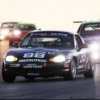
Okay, class, sorry for the dramatic title, but today we have a topic that is pretty darn important, yet almost never talked about directly. People talk about classes all the time (e.g. FP or ST3 or SRF or T1 or SM) of course. But we don't often talk about classes of classes. Or, if you hang around with academic types, meta-classes. The idea of classes of classes is that we can usefully group classes together so that as you choose classes to run you are "shopping" within a group that has the characteristics you are looking for.
There is no standard definition of classes of classes, so we'll propose one that we think is useful. But when talking to people in the sport, you may get blank stares if you bring up this taxonomy. Our focus is on classes of classes for driving on track (road racing courses). Here we go:
Street Cars. You know what these are, but for definitional purposes these are cars that can be registered for driving on the street. Therefore, these have emissions controls and windows and DOT treaded tires and lights and no roll cage (might have roll bar or harness bar).
Builder Classes. Builder classes are those where there is a broad technical definition of the class (e.g. maximum weight:power of 10:1 or a list of allowed/prohibited modifications) and then many cars that fit that definition are allowed. Until recently, this was the predominant class of classes. The big point here is that you will be competing against cars that are broadly similar but specifically different (different chassis, different engines, different aero, different suspension, etc). This gives you the chance to find legal technical advantages that the other guy doesn't have. It also means that if the class you pick has ample technical flexibility, you may find yourself in an expensive class because the rules are open to expensive things and some drivers do those things (e.g. sequential gearboxes).
Spec Classes. Spec classes, in principle have pretty much everyone running the same car. That is, most spec classes specify a particular chassis, engine, transmission, springs, shocks, tires, engine tuning parameters and more. There are different degrees of tightness to these specified items. For example, the classic spec class is Spec Miata, but SM allows four different chassis/engine combinations, engines are not identical or sealed, and some cars are not built to the full limit of the spec. In contrast, MX-5 Cup has one chassis, one sealed engine build, all cars must comply with the existing spec and parts are swapped between competing cars. Spec classes aim to do two things: keep costs controlled to a range and put the emphasis on driver skill over builder innovation.
BOP Classes. The most recent innovation in classes of classes is the BOP (Balance Of Performance) group. In one sense, this is an effort to capture most of the spec cost control advantage, while having different chassis/engine combinations on track (which is attractive to drivers and spectators). Cars in the BOP group are generally factory built (e.g. Audi or Porsche or BMW or Ford). BOP is mainly used in Pirelli World Challenge and IMSA racing, and as a result the cars and the series costs are rather high when compared with club racing. But if you are running a series that costs $300,000 per year, you can imagine that you don't want that to escalate to $500,000 just because the rules are flexible (our experience is that everyone has a budget limit). What you have to accept in the BOP group is that analysis of physics data from cars like yours will be used to balance the capabilities of your car type so that over a range of tracks you should do the same lap times as different cars in your class, assuming you have equal drivers. Some people trust this process, some don't, which is a big factor to consider. But, in principle the driver matters most and yet you still get to drive a super-cool Bentley.
We should say that there are lower-cost and higher-cost ways to do all of these. Of course, we'd generally say the street car group is the lowest cost and the BOP group is the highest cost. But, if you buy a McLaren P1 street car, it could hardly be called low cost. And in the BOP group, you can run PWC TCA in an MX-5 Cup car, which isn't low cost, but there are many higher cost classes. So there's a range and we recommend doing your homework.
The big difference, though, in these groups is that the basis of competition changes between them. In Street Cars there mostly isn't direct competition. Many drivers like this because they like being on track, but they just want to work on technique or have fun. They may dislike the stress of competition or the cost of wheel-wheel damage. In Builder Classes, a good driver helps, but you can also compete on technical merit, so if you like designing cars and/or working on them, you get to have fun all year long. Spec and BOP classes place a premium on driver talent, which appeals to drivers who like close competition and want to benchmark their skills.




 Sign In
Sign In Create Account
Create Account












 Back to top
Back to top Report
Report




